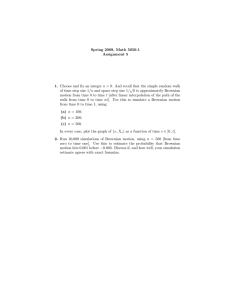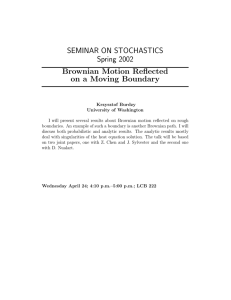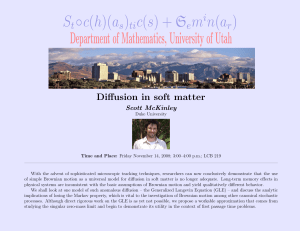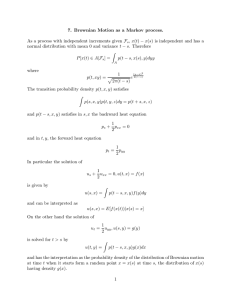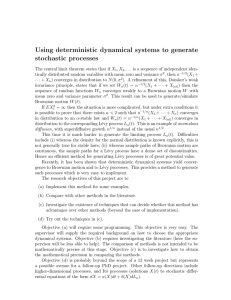Document 13620598
advertisement
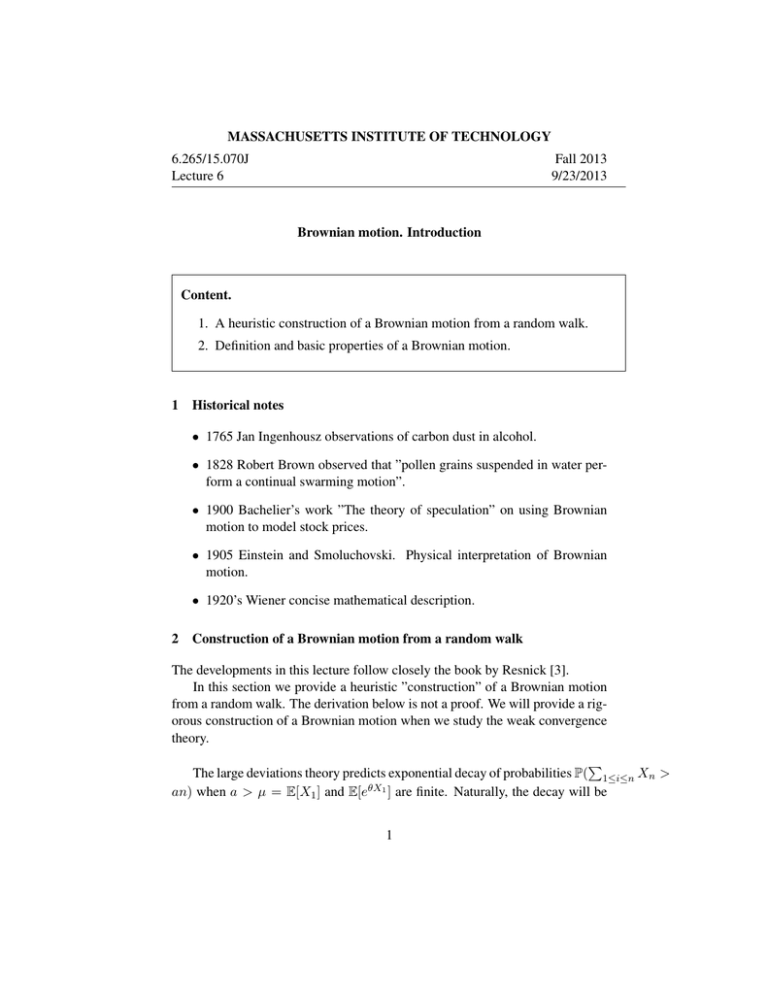
MASSACHUSETTS INSTITUTE OF TECHNOLOGY
6.265/15.070J
Lecture 6
Fall 2013
9/23/2013
Brownian motion. Introduction
Content.
1. A heuristic construction of a Brownian motion from a random walk.
2. Definition and basic properties of a Brownian motion.
1
Historical notes
• 1765 Jan Ingenhousz observations of carbon dust in alcohol.
• 1828 Robert Brown observed that ”pollen grains suspended in water per­
form a continual swarming motion”.
• 1900 Bachelier’s work ”The theory of speculation” on using Brownian
motion to model stock prices.
• 1905 Einstein and Smoluchovski. Physical interpretation of Brownian
motion.
• 1920’s Wiener concise mathematical description.
2
Construction of a Brownian motion from a random walk
The developments in this lecture follow closely the book by Resnick [3].
In this section we provide a heuristic ”construction” of a Brownian motion
from a random walk. The derivation below is not a proof. We will provide a rig­
orous construction of a Brownian motion when we study the weak convergence
theory.
The large deviations theory predicts exponential decay of probabilities P( 1≤i≤n Xn >
an) when a > µ = E[X1 ] and E[eθX1 ] are finite. Naturally, the decay will be
1
slower the closer a is to µ. We considered only the case when a was a constant.
But what if a is a function of n: a = an ? The Central Limit Theorem tells us
that the ”decay” disappears when an ≈ √1n . Recall
Theorem 1 (CLT). Given an i.i.d. sequence (Xn , n ≥ 1) with E[X1 ] =
µ, var[X1 ] = σ 2 . For every constant a
P
a
t2
1
1≤i≤n Xi − µn
√ e− 2 dt.
√
lim P(
≤ a) =
n→∞
σ n
2π
−∞
P
= 1≤i≤n (Xi − µ). For
Now let us look at a sequence of partial sums Sn P
simplicity assume µ = 0 so that we look at Sn =
1≤i≤n Xi . Can we say
anything about Sn as a function of n? In fact, let us make it a function
o of a real
√
Xi
√ J
variable t ∈ R+ and rescale it by n as follows. Define Bn (t) = 1≤i≤�nt
n
for every t ≥ 0.
Denote by N (µ, σ 2 ) the distribution function of a normal r.v. with mean µ
and variance σ 2 .
1. For every fixed 0 ≤ s < t, by CLT we have the distribution of
P
lnsJ<i≤lntJ Xi
σ
lntJ − lnsJ
converging to the standard normal distribution as n → ∞. Ignoring the
difference between lntJ − lnsJ and n(t − s) which is at most 1, and
writing
P
Bn (t) − Bn (s)
st<i≤nt Xi
√
√
=
σ nt − ns
σ t−s
we obtain that Bn (t)−Bn (s) converges in distribution to N (0, σ 2 (t−s)).
o
2. Fix t1 < t2 and consider Bn (t1 ) =
o
nt1 <i≤nt2
√
1≤i≤nt1
√
n
Xi
and Bn (t2 ) − Bn (t1 ) =
Xi
. The two sums contain different elements of the sequence
X1 , X2 , . . .. Since the sequence is i.i.d. Bn (t1 ) and Bn (t2 ) − Bn (t1 ) are
independent. Namely for every x1 , x2
n
P(Bn (t1 ) ≤ x1 , Bn (t2 ) − Bn (t1 ) ≤ x2 ) = P(Bn (t1 ) ≤ x1 )P(Bn (t2 ) − Bn (t1 ) ≤ x2 ).
This generalizes to any finite collection of increments Bn (t1 ), Bn (t2 ) −
Bn (t1 ), . . . , Bn (tk )−Bn (tk−1 ). Thus Bn (t) has independent increments.
2
3. Given a small E, for every t the difference Bn (t + E) − Bn (t) converges
in distribution to N (0, σ 2 E). When E is very small this difference is very
close to zero with probability approaching 1 as n → ∞. Namely, Bn (t)
is increasingly close to a continuous function as n → ∞.
4. Bn (0) = 0 by definition.
3
Definition
The Brownian motion is the limit B(t) of Bn (t) as n → ∞. We will delay an­
swering questions about the existence of this limit as well as the sense in which
we take this limit (remember we are dealing with processes and not values here)
till future lectures and now simply postulate the existence of a process satisfy­
ing the properties above. In the theorem below, for every continuous function
ω ∈ C[0, ∞) we let B(t, ω) denote ω(t). This notation is more consistent with
a standard convention of denoting Brownian motion by B and its value at time t
by B(t).
Definition 1 (Wiener measure). Given Ω = C[0, ∞), Borel σ-field B defined
on C[0, ∞) and any value σ > 0, a probability measure P satisfying the follow­
ing properties is called the Wiener measure:
1. P(B(0) = 0) = 1.
2. P has the independent increments property. Namely for every 0 ≤ t1 <
· · · < tk < ∞ and x1 , . . . , xk−1 ∈ R,
P(ω ∈ C[0, ∞) : B(t2 , ω) − B(t1 , ω) ≤ x1 , . . . , B(tk , ω) − B(tk−1 , ω) ≤ xk−1 )
P(ω ∈ C[0, ∞) : B(ti , ω) − B(ti−1 ), ω) ≤ xi−1 )
=
2≤i≤k
3. For every 0 ≤ s < t the distribution of B(t)−B(s) is normal N (0, σ 2 (t−
s)). In particular, the variance is a linear function of the length of the time
increment t − s and the increments are stationary.
The stochastic process B described by this probability space (C[0, ∞), B, P)
is called Brownian motion. When σ = 1, it is called the standard Brownian
motion.
3
Theorem 2 (Existence of Wiener measure). For every σ ≥ 0 there exists a
unique Wiener measure.
(what is the Wiener measure when σ = 0?). As we mentioned before, we delay
the proof of this fundamental result. For now just assume that the theorem holds
and study the properties.
Remarks :
• In future we will not be explicitly writing samples ω when discussing
Brownian motion. Also when we say B(t) is a Brownian motion, we un­
derstand it both as a Wiener measure or simply a sample of it, depending
on the context. There should be no confusion.
• It turns out that for any given σ such a probability measure is unique. On
the other hand note that if B(t) is a Brownian motion, then −B(t) is also
a Brownian motion. Simply check that all of the conditions of the Wiener
measure hold. Why is there no contradiction?
• Sometimes we will consider a Brownian motion which does not start at
zero: B̄(0) = x for some value x = 0. We may define this process as
x + B(t), where B is Brownian motion.
Problem 1.
1. Let Ω be the space of all (not necessarily continuous) functions ω : R+ →
R.
i Construct an example of a stochastic process in Ω which satisfies
conditions (a)-(c) of the Brownian motion, but such that every path
is almost surely discontinuous.
i Construct an example of a stochastic process in Ω which satisfies
conditions (a)-(c) of the Brownian motion, but such that every path
is almost surely discontinuous in every point t ∈ [0, 1].
HINT: work with the Brownian motion.
2. Suppose B(t) is a stochastic process defined on the set of all (not neces­
sarily continuous) functions x : R+ → R satisfying properties (a)-(c) of
Definition 1. Prove that for every t ≥ 0, limn→∞ B(t+ n1 ) = B(t) almost
surely.
4
Problem 2. Let AR be the set of all homogeneous linear functions x(t) = at
where a varies over all values a ∈ R. B(t) denotes the standard Brownian
motion. Prove that P(B ∈ AR ) = 0.
4
Properties
We now derive several properties of a Brownian motion. We assume that B(t)
is a standard Brownian motion.
Joint distribution. Fix 0 < t1 < t2 < · · · < tk . Let us find the joint distribution
of the random vector (B(t1 ), . . . , B(tk )). Given x1 , . . . , xk ∈ R let us find
the joint density of (B(t1 ), B(t2 ), . . . , B(tk )) in (x1 , . . . , xk ). It is equal to
the joint density of (B(t1 ), B(t2 ) − B(t1 ), . . . , B(tk ) − B(tk−1 )) in (x1 , x2 −
x1 , . . . , xk − xk−1 ), which by independent Gaussian increments property of the
Brownian motion is equal to
kY
−1
i=1
1
−
2π(ti+1 − ti )
e
(xi+1 −xi )2
2(ti+1 −ti )
.
Differential Property. For any s > 0, Bs (t) = B(t + s) − B(s), t ≥ 0
is a Brownian motion. Indeed Bs (0) = 0 and the process has independent
increments Bs (t2 ) − Bs (t1 ) = B(t2 + s) − B(t1 + s) which have a Guassian
distribution with variance t2 − t1 .
Scaling. For every c, cB(t) is a Brownian motion with variance σ 2 = c2 .
Indeed, continuity and the stationary independent increment properties as well
as the Gaussian distribution of the increments, follow immediately. The variance
of the increments cB(t2 ) − cB(t1 ) is c2 (t2 − t1 ).
For every positive c > 0, B( ct ) is a Brownian motion with variance 1c . Indeed, the process is continuous. The increments are stationary, independent with
Gaussian distribution. For every t1 < t2 , by definition of the standard Brownian
motion, the variance of B( tc2 ) − B( tc1 ) is (t2 − t1 )/c = 1c (t2 − t1 ).
Combining these two properties we obtain that
nian motion.
5
√
cB( ct ) is also a standard Brow-
Covariance. Fix 0 ≤ s ≤ t. Let us compute the covariance
Cov(B(t), B(s)) = E[B(t)B(s)] − E[B(t)]E[B(s)]
a
= E[B(t)B(s)]
= E[(B(s) + B(t) − B(s))B(s)]
b
= E[B 2 (s)] + E[B(t) − B(s)]E[B(s)]
= s + 0 = s.
Here (a) follows since E[B(t)] = 0 for all t and (b) follows since by definition
of the standard Brownian motion we have E[B 2 (s)] = s and by independent
increments property we have E[(B(t)−B(s))B(s)] = E[(B(t)−B(s))(B(s)−
B(0))] = E[(B(t) − B(s)]E[(B(s) − B(0)] = 0, since increments have a zero
mean Gaussian distribution.
Time reversal. Given a standard Brownian motion B(t) consider the process
B (1) (t) defined by B (1) (t) = tB( 1t ) for all t > 0 and B (1) (0) = 0. In other
words we reverse time by the transformation t → 1t . We claim that B (1) (t) is
also a standard Brownian motion.
Proof. We need to verify properties (a)-(c) of Definition 1 plus continuity. The
continuity at any point t > 0 follows immediately since 1/t is continuous func­
tion. B is continuous by assumption, therefore tB( 1t ) is continuous for all t > 0.
The continuity at t = 0 is the most difficult part of the proof and we delay it till
the end. For now let us check (a)-(c).
(a) follows since we defined B (1) (0) to be zero.
We delay (b) till we establish normality in (c)
(c) Take any s < t. Write tB( 1t ) − sB( 1s ) as
1
1
1
1
1
tB( ) − sB( ) = (t − s)B( ) + sB( ) − sB( )
t
s
t
t
s
The distribution of B( 1t )−B( 1s ) is Gaussian with zero mean and variance 1s − 1t ,
since B is standard Brownian motion. By scaling property, the distribution of
sB( 1t )−sB( 1s ) is zero mean Gaussian with variance s2 ( 1s − 1t ). The distribution
of (t − s)B( 1t ) is zero mean Gaussian with variance (t − s)2 ( 1t ) and also it
is independent from sB( 1t ) − sB( 1s ) by independent increments properties of
6
the Brownian motion. Therefore tB( 1t ) − sB( 1s ) is zero mean Gaussian with
variance
1 1
1
s2 ( − ) + (t − s)2 ( ) = t − s.
s
t
t
This proves (c).
We now return to (b). Take any t1 < t2 < t3 . We established in (c) that all
the differences B (1) (t2 ) − B (1) (t1 ), B (1) (t3 ) − B (1) (t2 ), B (1) (t3 ) − B (1) (t1 ) =
B (1) (t3 ) − B (1) (t2 ) + B (1) (t2 ) − B (1) (t1 ) are zero mean Gaussian with vari­
ances t2 − t1 , t3 − t2 and t3 − t1 respectively. In particular the variance of
B (1) (t3 ) − B (1) (t1 ) is the sum of the variances of B (1) (t3 ) − B (1) (t2 ) and
B (1) (t2 ) − B (1) (t1 ). This implies that the covariance of the summands is zero.
Moreover, from part (b) it is not difficult to establish that B (1) (t3 ) − B (1) (t2 )
and B (1) (t2 ) − B (1) (t1 ) are jointly Gaussian. Recall, that two jointly Gaussian
random variables are independent if and only if their covariance is zero.
It remains to prove the continuity at zero of B (1) (t). We need to show the
continuity almost surely, so that the zero measure set corresponding to the sam­
ples ω ∈ C[0, ∞) where the continuity does not hold, can be thrown away.
Thus, we need to show that the probability measure of the set
1
A = {ω ∈ C[0, ∞) : lim tB( , ω) = 0}
t→0
t
is equal to unity.
We will use Strong Law of Large Numbers (SLLN). First set t = 1/n
and consider tB( 1t ) = B (n)/n. Because of the independent Gaussian incre­
ments property B(n) = 1≤i≤n (B(i) − B(i − 1)) is the sum of independent
i.i.d. standard normal random variables. By SLLN we have then B(n)/n →
E[B(1) − B(0)] = 0 a.s. We showed convergence to zero along the sequence
t = 1/n almost surely. Now we need to take care of the other values of t, or
equivalently, values s ∈ [n, n + 1). For any such s we have
|
B(s) B(n)
B(s) B(n)
B(n) B(n)
−
|≤|
−
|+|
−
|
s
n
s
s
s
n
1 1
1
≤ |B(n)|| − | +
sup |B(s) − B(n)|
s n
n n≤s≤n+1
≤
|B(n)| 1
+
sup |B(s) − B(n)|.
n2
n n≤s≤n+1
We know from SLLN that B(n)/n → 0 a.s. Moreover then
B(n)/n2 → 0.
7
(1)
a.s. Now consider the second term and set Zn = supn≤s≤n+1 |B(s) − B(n)|.
We claim that for every E > 0,
P(Zn /n > E i.o.) = P(ω ∈ C[0, ∞) : Zn (ω)/n > E i.o.) = 0
(2)
where i.o. stands for infinitely often. Suppose (2) was indeed the case. The
equality means that for almost all samples ω the inequality Zn (ω)/n > E hap­
pens for at most finitely many n. This means exactly that for almost all ω (that
is a.s.) Zn (ω)/n → 0 as n → ∞. Combining with (1) we would conclude that
a.s.
B(s) B(n)
−
| → 0,
sup |
s
n
n≤s≤n+1
as n → ∞. Since we already know that B(n)/n → 0 we would conclude that
a.s. lims→∞ B(s)/s = 0 and this means almost sure continuity of B (1) (t) at
zero.
It remains to show (2). We observe that due to the independent stationary
increments property, the distribution of Zn is the same as that of Z1 . This is
the distribution of the maximum of the absolute value of a standard Brownian
motion during the interval [0, 1]. In the following lecture we will show that this
maximum has finite expectation: E[|Z1 |] < ∞. On the other hand
Z ∞
∞ Z (n+1)�
0
E[|Z1 |] =
P(|Z1 | > x)dx =
P(|Z1 | > x)dx
0
n=0 n�
∞
0
≥E
P(|Z1 | > (n + 1)E).
n=0
We conclude that the sum in the right-hand side is finite. By i.i.d. of Zn
∞
0
n=1
∞
0 |Z1 |
|Zn |
P(
> E) =
P(
> E)
n
n
n=1
Thus the sum on the left-hand side is finite. Now we use the Borel-Cantelli
Lemma to conclude that (2) indeed holds.
5
Additional reading materials
• Sections 6.1 and 6.4 from Chapter 6 of Resnick’s book ”Adventures in
Stochastic Processes” in the course packet.
• Durrett [2], Section 7.1
• Billingsley [1], Chapter 8.
8
References
[1] P. Billingsley, Convergence of probability measures, Wiley-Interscience
publication, 1999.
[2] R. Durrett, Probability: theory and examples, Duxbury Press, second edi­
tion, 1996.
[3] S. Resnick, Adventures in stochastic processes, Birkhuser Boston, Inc.,
1992.
9
MIT OpenCourseWare
http://ocw.mit.edu
15.070J / 6.265J Advanced Stochastic Processes
Fall 2013
For information about citing these materials or our Terms of Use, visit: http://ocw.mit.edu/terms.

